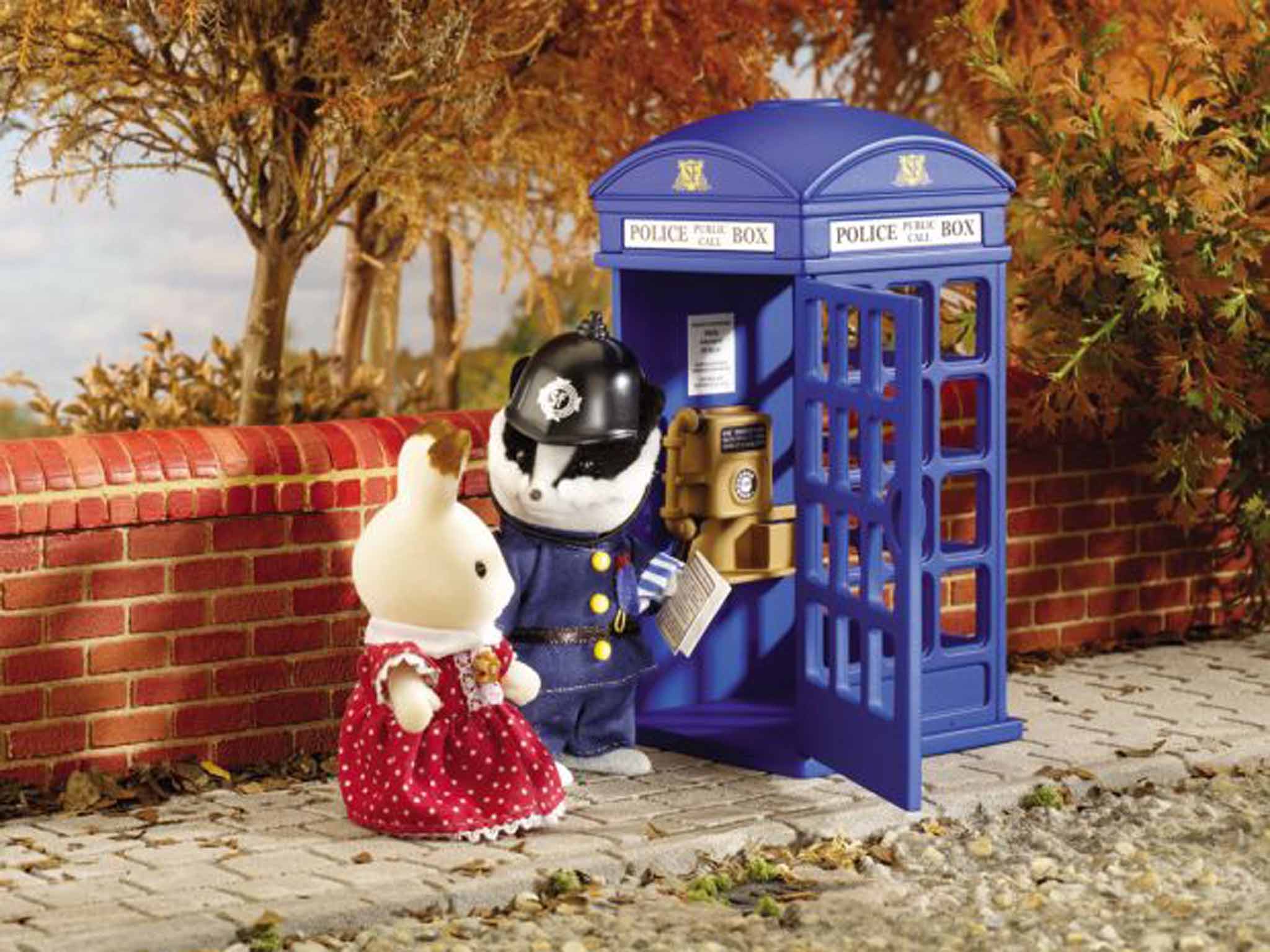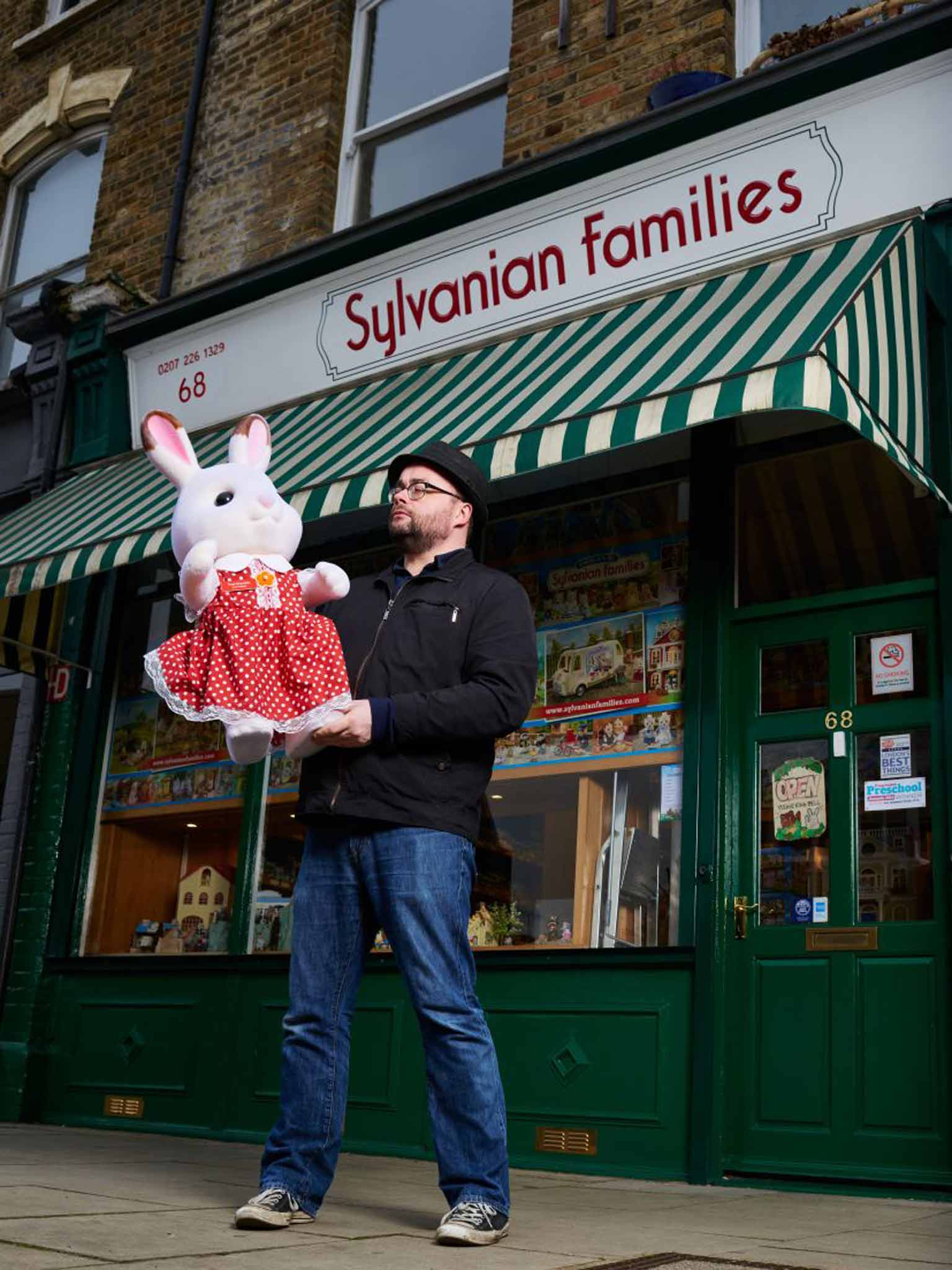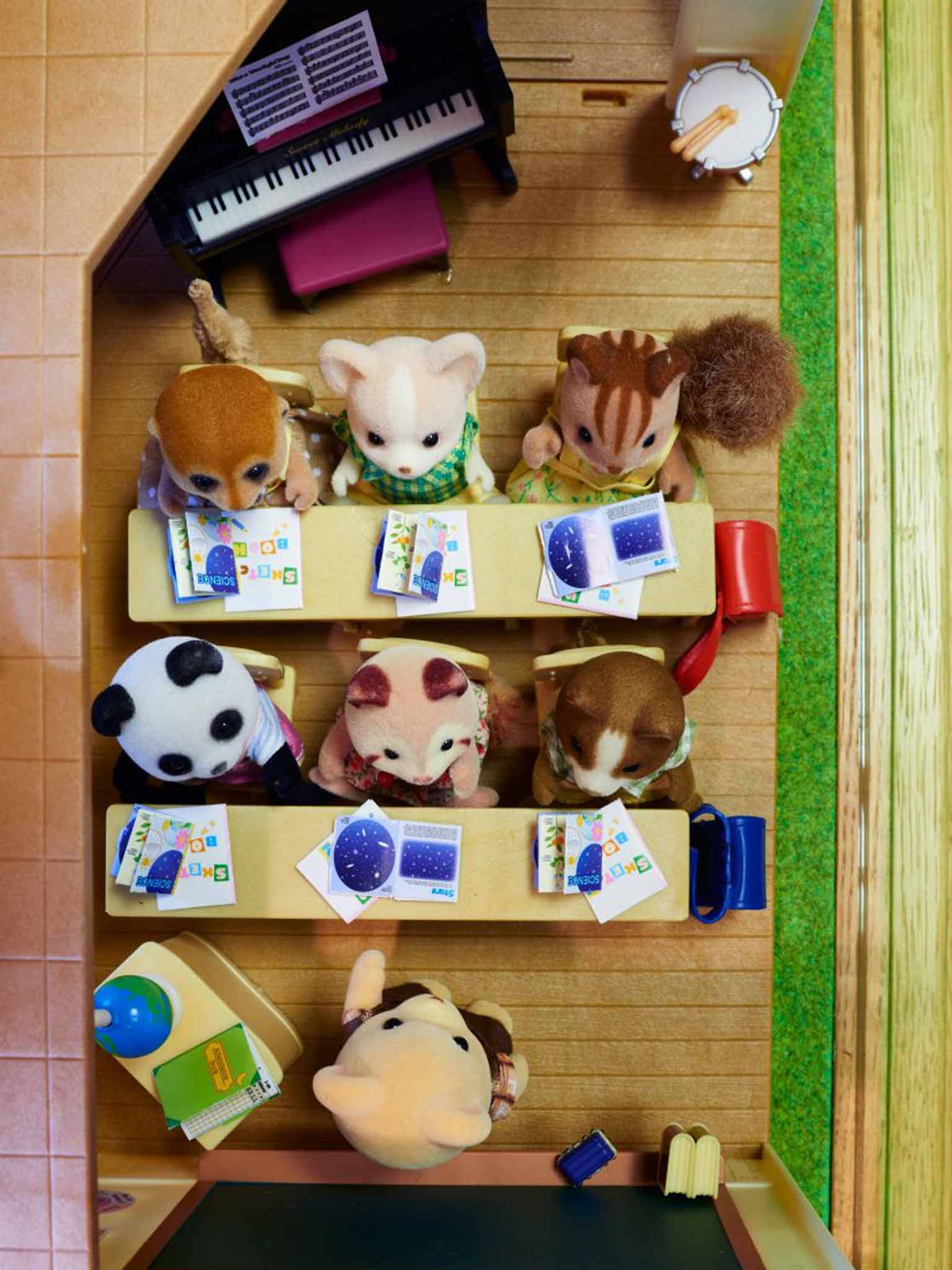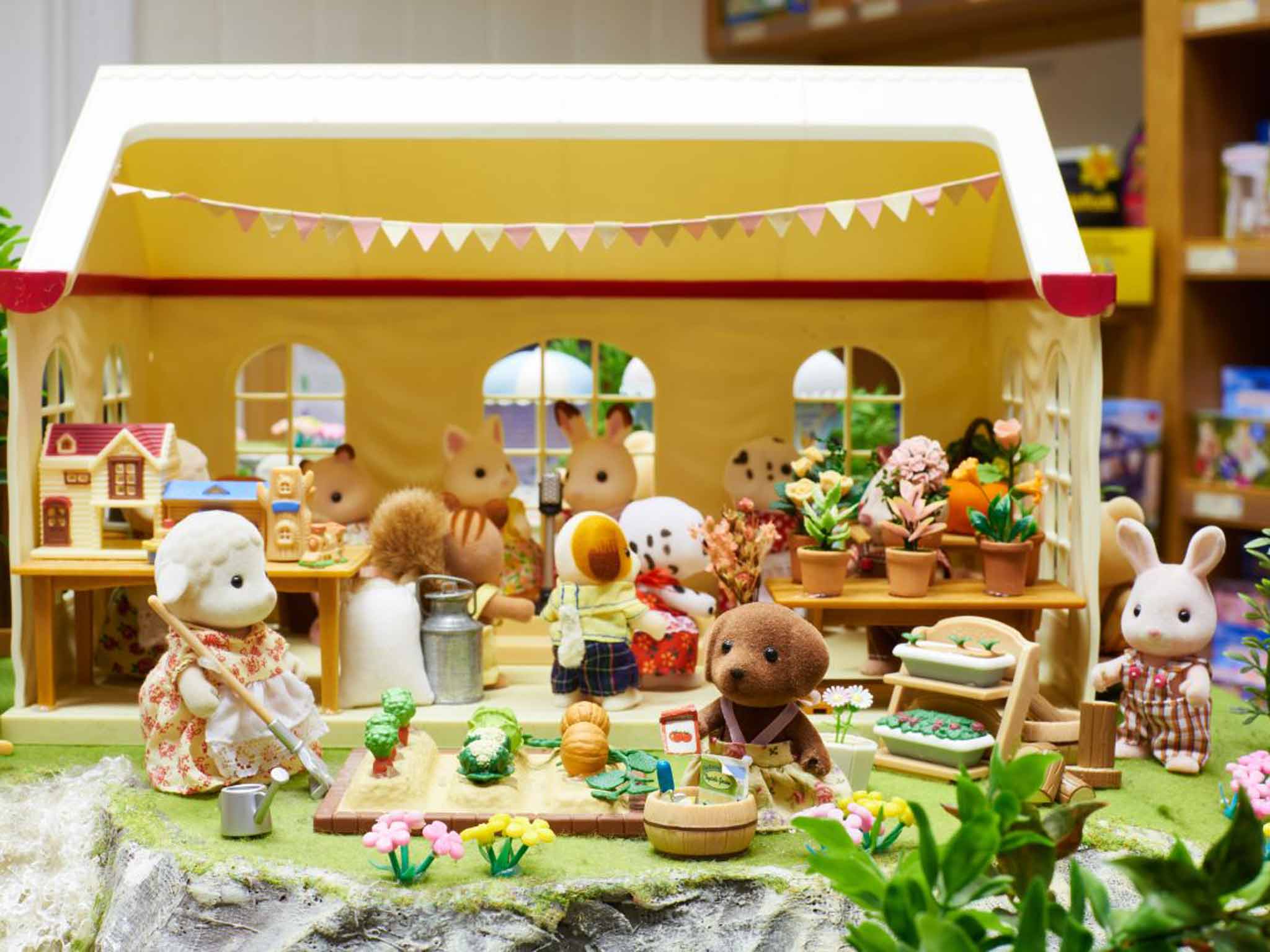Sylvanian Families: How folksy ways and wholesome values captured a global audience
Dreamt up in Japan as an antidote to high-rise living, Sylvanian Families have sold over 40 million figures in the UK alone. Rhodri Marsden discovers some creature comforts in a pastoral, low-tech world.

"Wholesome." If an adult ever admits to you, privately, that they’re a fan of Sylvanian Families, that's the word that will eventually slip out. Wholesome. No Sylvanian Families character would ever get bladdered and wrap their car around a lamp post, or kick a pigeon, or burp in a church. Evidence of that wholesomeness is on public display in the window of a small shop on a back street in north London.
Under a striped green and white awning and behind panes of sparkling glass, dozens of anthropomorphic animal figurines, neatly dressed in homely garments and standing about four inches tall, are engaged in thoroughly wholesome pursuits. A painstakingly built diorama of a bustling garden fête depicts such virtuous activities as sweeping, baking and close-harmony singing. The contrast between these guys and, say, the fearsome menace of a Transformers Age of Extinction Stomp And Chomp Grimlock could not be greater.
"In the world of Sylvania, nothing bad ever happens," says Ben Miller-Poole, 34, who's worked at the country’s only dedicated Sylvanian Families shop for the last 11 years. "Everyone's lovely. There are no problems. The most difficult decision you're going to have to make is what sandwich to take out of the picnic basket. The only reason there's a Sylvanian policeman is in case someone's football gets stuck up a tree." That policeman is, I learn later, PC Bobby Roberts, a badger as well as an officer of the law. According to the blurb, he has "a friendly word for everyone he meets – except if they've been naughty, then he has a stern word with them and takes them back home to their mother!"
But in the two hours that I spend immersed in the world of Sylvania, I see no scenes of moderate violence (to borrow a phrase from the British Board of Film Classification). No scenes of mild peril. No scary moments. No need for PC Bobby Roberts whatsoever. I almost forget about my mortgage and my nagging shoulder pain. It’s really, really nice.

This week marks the 30th anniversary of the launch of "Pleasant Friends Of The Forest Epoch System Collection Animal Toy Sylvanian Families", a Japanese toy that was, rather sensibly, renamed "Sylvanian Families". Over the years, Sylvania has become very diverse, biologically-speaking: you’ll find cats (Persian, silk and "Celebration"), mice, rabbits, otters, hedgehogs, squirrels, meerkats, Dalmatians, kangaroos, monkeys, elephants, sheep, bears, pandas (red as well as giant) and beavers. And that’s just for starters.
A standard family of four (single-species only, natch) will set you back £15.99, but it’s not just animals that make up the Sylvanian civilisation. There’s an ever-growing infrastructure of homes, civic structures, shops, transport solutions and leisure facilities. There’s even the Sylvanian Families Country Dentist Set (£14.99) which comes with a reclining chair, mouth rinser, toothbrush and various tools, all overseen by Dr Periwinkle, who’s almost certainly a really nice chap who inflicts no pain on anyone.
Sylvanian figurines don’t do anything by themselves; you buy a set, perhaps with a few accessories, and then you (or your children, if you’re a bit busy) position them. You move them about and tell your own stories. If you try to passively interact with Sylvanian Families, nothing will happen; it’s down to you and your imagination. It’s just like the dolls’ houses that our grandmothers might have played with, except the characters are a bunch of impossibly cute, lightly fuzzy, creatures. And granny probably didn’t have access to a doll-size Supermarket (£39.99), Fish and Chips Van (£29.99) or Country Tree School (£34.99).
Needless to say, the retro appeal is colossal. "Every now and then you get someone in the shop who can’t believe that they’re buying them for themselves," says Miller-Poole. "But the spectrum of people who like them is so broad. We’ve been running the club magazine for years, and have had members as old as 88, right down to children who’ve not even been born yet, whose expectant mothers have signed them up."
Sylvanian Families was the brainchild of an executive at the Japanese toy firm Epoch, who reckoned that a simulacrum of a rural English idyll would enchant Japanese children who spent most of their lives in high-rise buildings. The brand has remained consistently popular in Japan, with manifestations of Sylvania to be found in stage shows, theme parks and themed restaurants. But it ended up enchanting much of the Western world, too. In the US, retitled "Calico Critters", it was a copper-bottomed hit, and when the toys went on sale in the UK in 1987 we went nuts for it.

It was named Toy of The Year for three years in succession, and has continued to win awards for its detailed modelling, the way it facilitates imaginative play and, of course, its wholesomeness. In 1992, Angela and Simon Harwood, a British couple who ran a Sylvanian token-collecting scheme on behalf of the then UK manufacturer, Tomy, were so inundated with children sending them tokens in exchange for freebies that in 1992 they decided to move the business into empty premises around the corner from their home; the Sylvanian Families shop I’m standing in is the result.
"I was a huge fan as a child," says Sally Carnall, 27, who is now the marketing manager at Epoch in the UK. "The otter family would have been my favourite. And the canal boat. I was featured in a magazine with my collection when I was ten or eleven, and me and my friend would make regular visits to the shop in London. I’d collect the tokens and every year my mum would take us down there."
In 2015, a regular stream of curious passers-by still wander in off the street to gawp at the displays, which almost seem frozen in time. Victor Tailbury, the father of the Tailbury dog family, sits with a gardening book and a crossword puzzle, while his wife, Purdy, stands in a kitchen alongside an array of tiny fresh (plastic) vegetables. These four-square families, all with two parents and two children, a boy and a girl of similar age, are either fantastically or appallingly nuclear, depending on your point of view. "Recently," says Miller-Poole, "some of the families have had two children of different ages – a child with a baby sister, say – so it has been shaken up a little bit. But no more than that." Progressive is certainly not the watchword, here. It’s "wholesome". (As we’ve already established.)
Toys aren’t popular for ever, and Sylvanian Families has had its share of ups and downs over the past 30 years. In the late 1990s, Tomy cut its losses and stopped production entirely in the UK, only for the brand to be revived 18 months later by a British company, Flair Leisure Products.
"After Tomy stopped making them, the shop was incredibly busy," says Miller-Poole, "because you genuinely couldn’t get them anywhere else. But then Peter Brown, the guy who brought Sylvanian Families to Tomy in the first place, started Flair and relaunched the brand. And we [at the shop] were very hands-on in terms of development. It became a very anglicised take on Sylvanian Families, playing up its quintessential Britishness." You can see this when you look around the shelves; there are gags only British people of a certain age would get, such as the driver and the conductor of the Woodland Bus being named Stan and Olive, a reference to the 1970s ITV sitcom On The Buses.
Flair’s association with the brand, however, ended last year. The creation and production of every Sylvanian Family is now tightly controlled by Epoch’s head office; the traditional blue packaging is now cream-coloured across all territories, and the description of each family member on the underside of the box is no longer there. "I don’t know why they’ve done it," says Miller-Poole, slightly mournfully. "We think it’s a bit of a shame… one of the things I remember from playing with them as a kid is turning the box over and thinking ‘Who IS this?’"

The backstories now appear online, instead, alongside the family group portrait and the add-to-basket button. There, you’ll find the improbably named members of the Persian cat family, Septimus, Salome, Nolly and Sadie Persis; Father Septimus is a master rug-maker, Mother Salome is an artist and painter, Brother Nolly likes climbing trees, while sister Sadie prefers to curl up in a sunny spot with a good book (rather than pen vitriolic poems about gender politics). And other changes are afoot under the new regime. "Every house used to look different," explains Miller-Poole, "different tiles, different finishes – but now they’re cream stone walls and red roofs, and they can all be clipped together. Epoch is very keen on connectability."
You sense that these changes don’t sit well with all Sylvanian connoisseurs, but there’s a lucrative second-generation market of parents ("predominantly mums", notes Miller-Poole) who played with them as children and are now eager to instil a bit of Sylvanian wholesomeness in their own offspring. Reviews of the range abound on parenting sites. "These little beasts are the bane of my life," writes one Mumsnetter. "Disgustingly over-priced teensy tiny bits and pieces which get all too easily lost and broken. They ARE cute though." But the intricate detail of these "teensy" pieces is precisely what attracts collectors and miniaturists who still hold Sylvanian Families in very high regard.
"There’s definitely a trend of parents wanting to go back to more traditional toys," says Carnall. "It’s about stimulating imagination and dexterity... it’s about love, family and nature." Is it almost two fingers to the digital world, I ask? "Ha – well, there’s no technology in Sylvania," she laughs. "It’s very wholesome."
The replies feed to the @SylvanianUK Twitter account is noticeably devoid of abuse, and online praise is effusive. "It’s nice that they encourage lots of imaginative play," reads another Mumsnet post. "Only down side is that they are quite pricey – but they do seem to last. A good choice as an alternative for children who aren’t so keen on dolls." That idea of imaginative, creative play is encouraged in the shop with models of papier maché and card, which Miller-Poole has built and used in the displays. Patterns for these can be downloaded at the shop’s website (sylvanianstorekeepers.com) and made at home. His knowledge of the range is encyclopaedic; when I dare to suggest that all the bear families look a bit similar, he’s at pains to point out the unique attributes of the Porridge family, and Chloe Porridge in particular. As he explains the intricate society of Sylvania, uniformed couriers arrive and depart carrying large boxes, full of Sylvanian items, with destinations marked from Brighton to Brazil. "There are people with huge collections overseas," says Miller-Poole, "and we’ll try to help them with shipping if, say, an eBay vendor won’t ship abroad."
I note with some bemusement that he’s wearing a name badge that says "Rocky". "Oh," he says, "so, we each play a Sylvanian character. When kids email me, they’ll get an email back from Rocky Babblebrook." (The real Rocky, in stark contrast to Miller-Poole, is a grey rabbit who runs the General Store, selling rakes and hoes and seeds.) "And my colleague," he continues, pointing towards a back room, "is Belinda Brighteyes." (Miller-Poole’s colleague is not a grey rabbit either – she’s a woman changing a printer cartridge.) "And who’s this?" I ask, pointing at an upscaled model of a rabbit in a spotty red dress. I quickly realise that I’ve betrayed my pathetic ignorance of Sylvania’s best-selling character. "She’s the most photographed rabbit in the world!" he replies, with mock indignation. "That’s Freya Chocolate, the eldest sister of the Chocolate family. She runs a bakery and a restaurant, and she’s everyone’s best friend. She’s also got concrete feet so she doesn’t fall over."
He informs me that Freya was once stolen by a drunk student from outside the shop. "It was in his wardrobe for six months," he says. "But in the end, when he moved out, he came in and confessed. And gave her back, rather sheepishly." PC Bobby Roberts was not informed about this incident. No charges were pressed, and no punishments were handed down. This is Sylvania, after all.
Students like them despite themselves, adults go a bit funny over them, but kids really love them. "Sylvanian Families are the best!" reads an online review by Megan, aged six. "I’ve got the beach," she continues. "They love my beach. I’ve got meerkat babies… and a car, too." But even for a cynical bloke like myself who likes moaning about how rubbish everything is, there’s something about the escapism offered by Sylvanian Families that’s curiously compelling. Because Sylvania is devoid of rubbish; it’s an idealistic utopia over which you can exercise total control. If you wanted to delve deep, the psychology of Sylvanian Families would be fascinating.
"My interest never really left me, to be honest," says Miller-Poole. "You might grow up and put your toys away but, as is common with a lot of people of my generation who are Sylvanian fans, you come back to it. And you get the same comforting feeling from it that you used to get as a child. A cosy safeness."
It’s a big year for the brand. Epoch, perhaps sensing a British hunger for wholesomeness, is launching a big advertising campaign, with online competitions, National Trust-partnered events in Hatchlands Park and Wallington, and a search to establish which village in the UK will be named Sylvania’s "twin".
But for many fans, the real-world location of Sylvania is already established. Thanks to its quaint picture-postcard charm and its picturesque silk mill, the Hampshire town of Whitchurch has been chosen to host a number of Sylvanian-related events, and Miller-Poole will be heading there at the end of June for a weekend of wholesome activities. "There’ll be a big marquee with the characters," he says, "things to do, spot the difference, treasure hunts, face painting…"
He laughs at my deadpan nod; for all his wide-eyed enthusiasm, he’s very aware of Sylvanian Families’ rather quaint position in the world of kids’ entertainment. "Well," he says, gesturing around him, "you can see that this shop is too small to put on events that create mass hysteria."
Join our commenting forum
Join thought-provoking conversations, follow other Independent readers and see their replies
Comments